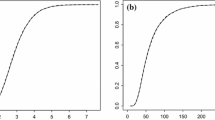Summary
A new discrepancy, the Gauss discrepancy of the logarithms of frequencies, is introduced for the selection of log-linear models for contingency tables. Under the assumption of Poisson sampling the loglinear model becomes orthogonal for this discrepancy: the model selection criterion is the sum of the contributions (to the criterion) of the effects in the model. It is, therefore, sufficient for model selection to compute the contributions of the effects in the saturated model. The selected model contains then all effects with negative contributions. It is not necessary to recompute the value of the criterion for all possible models. Two examples are given.
Zusammenfassung
Für die Auswahl log-linearer Modelle für Kontingenztafeln wird eine neue Diskrepanz eingeführt, die Gauss Diskrepanz zwischen den Logarithmen der Häufigkeiten. Unter der Annahme, daß die beobachteten Häufigkeiten Poisson-verteilt sind, wird das loglineare Modell für diese Diskrepanz orthogonal: das Modellauswahlkriterium ist die Summe der Beiträge (zum Kriterium) der Effekte im Modell. Zur Auswahl eines Modells genügt es also, die Beiträge der einzelnen Effekte des gesättigten Modells getrennt zu berechnen. Das ausgewählte Modell enthält dann alle Effekte mit negativen Beiträgen. Es ist nicht notwendig, den Wert des Kriteriums für jedes mögliche Modell neu zu berechnen. Zwei Beispiele werden durchgerechnet.
Similar content being viewed by others
References
Bishop Y, Fienberg S, Holland P (1975) Discrete multivariate analysis: theory and practice. MIT Press, Cambridge, Mass. London
Fahrmeir L, Hamerle A (1981) Kategoriale Regression in der betrieblichen Planung. Z Oper Res B25:63–78
Fienberg S (1980) The analysis of cross-classified categorical data. 2nd Edn. MIT Press, Cambridge Massachusetts London
Goodman L (1970) The multivariate analysis of qualitative data: interactions among multiple classifications. J Am Stat Ass 65:226–256
Goodman L (1971) The analysis of multidimensional contingency tables: stepwise procedures and direct estimation methods for building models for multiple classifications. Technometrics 13:33–61
Linhart H, Zucchini W (1986) Model selection. Wiley, New York
Pearson ES, Hartley HO (1972) Biometrika tables for statisticians, vol II. University Press, Cambridge
Upton G (1978) The analysis of cross-tabulated data. Wiley, New York
Author information
Authors and Affiliations
Rights and permissions
About this article
Cite this article
Böker, F. A criterion for selecting log-linear models for contingency tables. OR Spektrum 10, 167–172 (1988). https://doi.org/10.1007/BF01740511
Received:
Accepted:
Issue Date:
DOI: https://doi.org/10.1007/BF01740511




